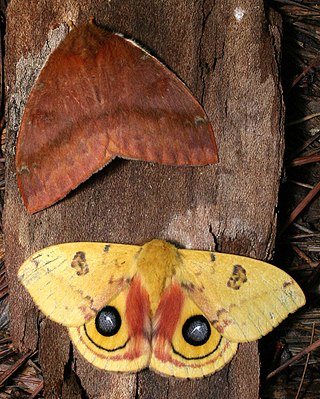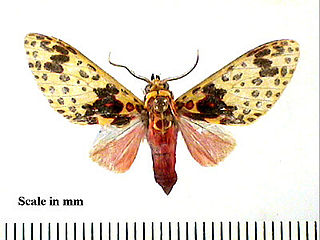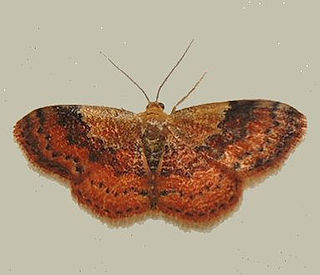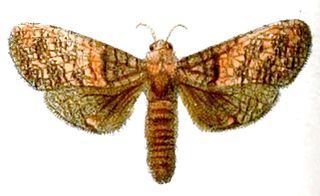
Automeris io, the Io moth or peacock moth, is a colorful North American moth in the family Saturniidae. The Io moth is also a member of the subfamily Hemileucinae. The name Io comes from Greek mythology in which Io was a mortal lover of Zeus. The Io moth ranges from the southeast corner of Manitoba and in the southern extremes of Ontario, Quebec, New Brunswick and Nova Scotia in Canada, and in the US it is found from Montana, North Dakota, South Dakota, Nebraska, Colorado, New Mexico, Texas, Utah, east of those states and down to the southern end of Florida. The species was first described by Johan Christian Fabricius in 1775.

Agylla, also formerly known as Churinga, is a genus of moths in the subfamily Arctiinae. The genus was erected by Francis Walker in 1854.

Amaxia is a genus of moths in the family Erebidae erected by Francis Walker in 1855. The type species of the genus is Amaxia pardalisWalker, 1855.
Lamprostola is a genus of moths in the subfamily Arctiinae described by William Schaus in 1899.
Metalobosia is a genus of moths in the subfamily Arctiinae. The genus was erected by George Hampson in 1900.

Haimbachia is a genus of moths of the family Crambidae.

Phostria is a genus of moths of the family Crambidae.

Streblote is a genus of moths in the family Lasiocampidae. It was described by Jacob Hübner in 1820.
Aplogompha is a genus of moths in the family Geometridae.

Cyclophora is a genus of moths in the family Geometridae. Many species are referred to as mochas in reference to their colouration, primarily in Europe.

Leptostales is a genus of moths in the family Geometridae.

Opisthoxia is a genus of moths in the family Geometridae.

Synchlora is a genus of moths in the family Geometridae erected by Achille Guenée in 1857. Adult Synchlora members often have leaf green wings, while larvae occasionally have the property of adorning themselves with pieces of plants in the pursuit of camouflage. The name of the genus comes from Greek, with "syn-" meaning "with", and "chlor" meaning "green".

The Chrysauginae are a subfamily of snout moths. They are primarily Neotropical and include about 400 described species.

Automeris is a genus of moths in the family Saturniidae and the subfamily Hemileucinae. As of 1996 there were 124 species, and more have since been described. These moths are generally characterized by the eyelike patches on the hindwings and the leaflike pattern on the forewings, an example of crypsis. The genus was first described by Jacob Hübner in 1819 and it is distributed in the Neotropical realm.

Automeris belti is a moth of the family Saturniidae first described by Herbert Druce in 1886. A. belti is found from Mexico to Colombia and Ecuador. The wingspan is 95–100 mm.

Hypopta is a genus of moths in the family Cossidae.
Schausiania is a genus of moths in the family Cossidae.

Automeris curvilinea is a species from the genus Automeris. The species was originally described in 1906 by William Schaus.














